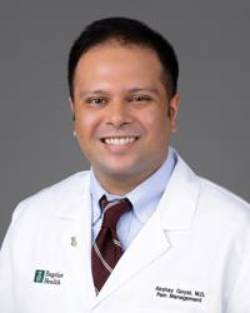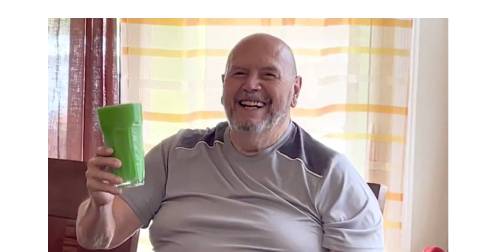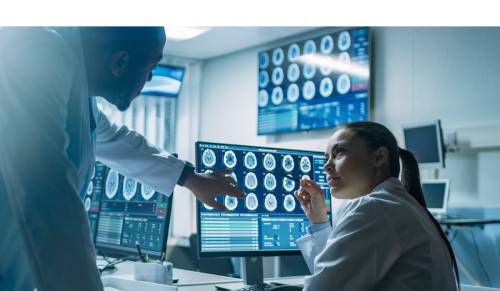
Science
Why Do Women Suffer More Chronic Pain Than Men? The Answer is Multifaceted.
3 min. read
Baptist Health Miami Neuroscience Institute
Chronic pain is defined as pain that lasts for more than three months, or longer than the usual recovery period after an illness, accident or surgery. It could be pain that occurs along with an ongoing health condition, such as arthritis.
Chronic pain may come and go, and it may affect people to such an extreme that it diminishes the quality and quantity of daily activities. Studies have found that there’s a gender gap in the field of chronic pain. It affects more women than men.

Akshay Goyal, M.D., a pain management physician at Baptist Health Miami Neuroscience Institute.
While there are no conclusive answers to the chronic pain disparity, ongoing research is trying to determine more precisely the factors driving this gap, explains Akshay Goyal, M.D., a pain management physician at Baptist Health Miami Neuroscience Institute. Dr. Goyal specializes in pain management and anesthesiology, with extensive experience in neuromodulation techniques for a variety of pain syndromes. Such techniques act directly on a patient’s nervous system.
“Anecdotally, I have seen more female patients that have difficult-to-treat conditions that may not be purely musculoskeletal in nature,” explains Dr. Goyal. “For instance, some data suggests that rheumatoid arthritis occurs in women three times as much as in men. Women are two to three times more likely to suffer from migraines than men. Fibromyalgia is present nine times more in women than in men. Abdominal and pelvic pain is skewed toward women as well.”
There are many causes of chronic pain for both men and women. It may have stemmed from an illness or injury. Or there may be an ongoing cause of pain, such as arthritis or cancer. Many people suffer chronic pain without having a past injury or illness. Some of the more common causes of chronic pain include: Previous surgery, an old injury, infection, diabetes, nerve damage, back issues, arthritis, and migraines or other headaches.
What primarily causes women to feel more chronic pain than men? There is no simple answer. Dr. Goyal refers to an article by Tina L. Doshi, M.D., assistant professor of Pain Medicine at Johns Hopkins University School of Medicine. “As with any complex subject, the devil is in the details,” he said. "Dr. Doshi describes it eloquently in an article, The Many Gender Gaps in Pain Management.”
Dr. Doshi writes: “These differences reflect a combination of genetic, biological/hormonal, psychological, social, and cultural factors that span different age groups, racial/ethnic categories, medical conditions, and socioeconomic classes, making the gender gap in pain patients a complex and widespread problem.”
Over the years, limited research had been done to better understand women’s chronic pain issues, and part of that is because of a historical tendency in medical research to ignore or downplay diseases that exclusively afflict women. In the past, that tendency has affected management of chronic pain in women.
“There are certainly historical sociological biases that exist in research that have not favored women,” explains Dr. Goyal. “In an article from The Journal of Pain Research, the authors find that there is a discrepancy between publications and research output between men and women. This divergence likely contributes to -- and further perpetuates -- implicit biases when evaluating women for promotion in faculty positions in academic pain institutions. These disparities may be improved by increased mentoring and awareness in the field of pain medicine.”
But the trend has shifted toward more women assuming leadership roles in the medical field of pain management. Moreover, recent medical studies have focused on learning the discrepancies of pain experienced between the genders. Dr. Goyal cites advancements in this area. For example, the North American Neuromodulation Society implemented a Women in Neuromodulation section in order to elevate women’s presence in the field of pain medicine. While the American Society of Pain and Neuroscience has regular events and programs focusing on mentorship, diversity, and inclusion.
“Research investigating disparities across a variety of populations has certainly gained traction in the recent years,” said Dr. Goyal. “Women are increasing their leadership presence in prominent medical positions, which will increase awareness and, in turn, improve the quality of care. “Technical advances in data collection and access to information will lead to more robust clinical data to help us in improving treatment of all demographics of chronic pain patients.”
Healthcare that Cares
Related Stories
View All Articles
‘My Shaking is Down to Zero’ -- Patient Undergoes Milestone 2nd High-Intensity Focused Ultrasound (HiFU) for Essential Tremor
March 5, 2024
3 min. read

The Neurosciences: A Miami Symposium Helps Advance Brain and Spine Care
December 13, 2023
3 min. read
Video

Roundup: 3 Dietary Factors Fuel Global Diabetes Surge; 1-in-5 U.S. Adults Suffer Chronic Pain; and More Health News
April 21, 2023
5 min. read